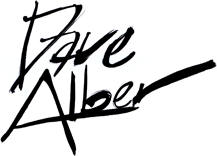Dave Alber creates Hybrid VR Paintings™, Travel Art, and Travel Writing. His art shares an experience of wonder at our cultural continuity and universal humanity.
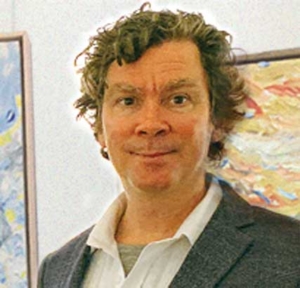
Dave Alber is the inventor of Hybrid VR Paintings™ and The Floating Gallery™.
Hybrid VR Paintings™ are physical/virtual hybrid paintings that occupy physical space on your wall while simultaneously manifesting within the virtual world.
The Floating Gallery™ is your app for exploring galleries of VR art.
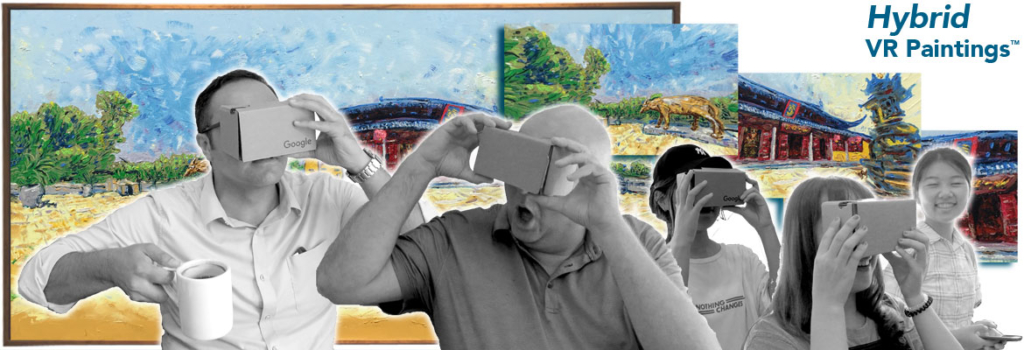
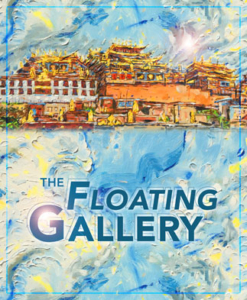
The Floating Gallery™—your gateway to Hybrid VR Paintings™—is, or will soon be, available on the following platforms and VR output formats:
-

Web/Mobile Web
-
iOS/Android/
Cardboard -
Gear VR
-
Oculus
-
Vive
-
and more
Dave Alber’s recent Travel Art exhibitions and events in Suzhou, Kunshan, and Shanghai, China have been:
-
-
Old World New World featuring Hybrid Oil 360° Panoramic VR Paintings (Kunchef, Kunshan, China),
-
Contact solo show (WangDe Art Shop, Suzhou, China),
-
Art Auction for Schoolchildren in Kenya with Nathan Pelton (WangDe Art Shop, Suzhou, China),
-
A Brief History of Impasto Painting (Suzhou Arts Collective, Suzhou, China),
-
Art Talk with Dave Alber (Elevate, Shanghai, China),
-
Art Drop Shanghai (Elevate, Shanghai, China),
-
Ravages of Time & Permanence of Wonder with Benj Kinenga (Suzhou Arts Collective, Suzhou, China),
-
INTIMATIONS solo show (Kunchef, Kunshan, China).
-
“What Lucian Freud does for portraiture, Dave Alber does for cityscapes.”
“These paintings can keep you open-minded and uplift your frequency.
“This combination of Western background and Eastern arts is quite profound and fantastic.”
Dave’s comic art and illustrations have appeared recently in That’s Shanghai, Suzhou Review, Shaving in the Dark, and Open Magazine. His comic “Bedding Shanghai” was featured in the Shanghai International Literary Festival.


“The effort that Dave put into making Bedding Shanghai… it’s just wonderful.”
“Honestly, I have thought so much about Puxi and Pudong, but I’ve never thought about it like this. So much effort. Thank you for sharing this with us. What a gift.”
“Very beautifully drawn. Simple and effective.”
THEORETICAL FOUNDATIONS:
“I create Travel Art. My Travel Art shares an experience of wonder at our cultural continuity and universal humanity.”
I see travel as a conversational opening for a dialogue about:
-
-
the experience of wonder,
-
our shared cultural continuity, and
-
our universal humanity.
-
Therefore…
“Travel Art is art that expresses wonder at the world we live in.”
I look to the emotional experience of wonder to explore how
-
-
representational art,
-
high level concepts, and
-
a deft manipulation of the picture plane
-
can invite a genuinely substantive communication with an art viewer.
For me…
“Wonder is the doorway:
-
-
to aesthetic pleasure,
-
to cultural and interpersonal connections,
-
to breaking old psychological habits of cynicism or materialism,
-
to directly experience the vitality of life, and
-
to genuine happiness.
-
Further—and this might require a stretch of the imagination—I believe that… our shared experience is ultimately a pulsation of wonder.
TECHNIQUES:
I work in a variety of mediums, though favor
-
-
impasto oil painting, and
-
Hybrid VR Paintings™.
-
“I believe in impasto as an expressive force for creating a rich vocabulary of texture.”
“Hybrid VR Paintings™ and The Floating Gallery™ give the art viewer an immersive experience completely new to the history of painting.
ARTIST JOURNEY
A STORY—IN REVERSE ORDER—OF MAKING AN ART OF TRAVEL
TRAVEL ART & TRAVEL WRITING 2018–Present :: China
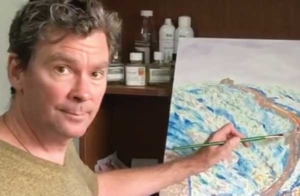
Dave Alber painting in his studio in Suzhou, China
Living and traveling abroad, I create Travel Art. I love to paint impasto oil paintings and hybrid oil 360° panoramic VR paintings. I paint travel scenes, portraits, landscapes, and cityscapes; I paint magazine illustrations and comic art as well as write travel writing for magazines. People connect with me to commission beautiful art personalized just for them, their families, and their businesses. I also enjoy connecting with my clients in the Travel Art Adventurer’s Club to share and bond together in our love of travel.
TEACHING & CHARACTER-BUILDING EXPERIENCES 2010–2018 :: China, Saudi Arabia, and Nepal
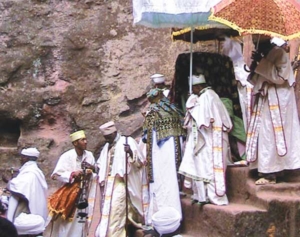
The Ark of the Covenant revealed in an Ethiopian festival
From a stable life in corporate America, I took a deep breath and a leap of faith and followed a dream overseas to Kathmandu, Nepal, where I started an online trauma recovery product business.
Losing all my money, I found myself down and out in Thailand and Taiwan. Re-strategizing, I began teaching in universities in China, Saudi Arabia, and Nepal.
Learning from past business errors, I started a second online business (Easy American Accent) through which I successfully published and promoted five books and two DVDs in the English Education market.
GRAPHIC DESIGNER / ILLUSTRATOR 1990–2010 :: USA
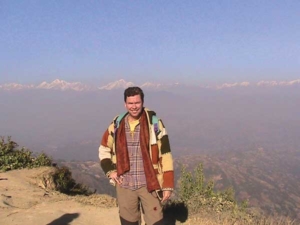
In the Nepalese Himalayas; Everest in the background
Before living and traveling in Asia, the Middle East, and Africa, I worked for a Fortune 500 company, drawing illustrations and designing literature for print, web, and multimedia.
However, a slow lassitude from ten years in the corporate world had begun to settle in, and so I began strategizing the creation of a life abroad. I wanted adventures in far off lands. I wanted to visit temples in the Himalayas, climb China’s holy mountains, experience the Middle East and Africa, and enjoy exuberant cultural festivals all over the world. At the time, I had no idea that an entire community of people might share this same desire to throw off the shackles of corporate confinements and make an art of travel.
Naïve about the journey, I began planning how to make an art of travel. However, it would take a leap of faith and journeys across several continents in order to learn how to do it successfully.
EXHIBITIONS, EDUCATION & ILLUSTRATIONS
SOLO EXHIBITIONS
2019 Old World New World, KunChef, Kunshan, Jiangsu, China (October 13–January 2020)
2019 Contact, WangDe Art Shop, Suzhou, Jiangsu, China (June 30–July 30)
2018 Intimations, KunChef, Kunshan, Jiangsu, China (December 30–June 14)
2006 Myth & Medium, Minds Eye Gallery, Campbell, CA
1998 Meditations, Neva Lomason Memorial Library, Carrolton, GA
GROUP EXHIBITIONS
2019 Ravages of Time & Permanence of Wonder, Suzhou Arts Collective, Suzhou, Jiangsu, China (March 8–May 11)
2008 A Sense of Place, Pacific Art League, Palo Alto
2007 Students of Cherise Thompson, Pacific Art League, Palo Alto
2007 Printmakers of the Pacific Art League, Pacific Art League, Palo Alto
2007 Figures: Human & Anatomical, Pacific Art League, Palo Alto
2000 Figurative Art, City Art, San Francisco, CA
1998–2000 The End of the World, starting at The University of Tennessee and touring the U.S. for two years
1997–1998 The Hand, three exhibits in Carrolton, Georgia
1996 The Renaissance Festival of Naples, Italy, (Art Director) USO, Naples, Italy
RECENT ART EVENTS
2019 Art Drop by ELEVATE in Shanghai (April 24)
2019 Art Talk by ELEVATE in Shanghai (April 21, 2019)
2019 A Brief History of Impasto Painting (April 11th)
2018 Shanghai International Literary Festival (May 18, 2018), exhibited comic art
EDUCATION
MA / Mythological Studies with an Emphasis in Depth Psychology 2002
Pacifica Graduate Institute, Carpenteria, CA
BFA / Concentrating in Printmaking 1999
The State University of West Georgia, Carrollton, GA
AA / Concentrating in Art 1991
St. Petersburg College, St. Petersburg, FL
Certificate in Graphic Design Technology 1991
Pinellas Vocational Technical Institute, Largo, FL
RECENT PUBLICATIONS
2019 Dave Alber: Travel Art 2019: Ravages of Time & Permanence of Wonder ISBN-10: 1689274565
2019 Travel Art & Travel Writing: A Curious Heart’s Wanderlust in China ISBN-10: 1086903560
2018 Dave Alber: Travel Art 2018: Part 1: Intimations ISBN-10: 1724953346
2016 Heart of Myth: Wisdom Stories From Endangered People ISBN-10: 1534785515
2014 The Taotie Image in Chinese Art, Culture, and Cosmology ISBN-10: 1497355206
RECENT PUBLISHED ILLUSTRATIONS
Open Magazine, Suzhou Review, That’s Shanghai, That’s Suzhou, That’s Guangzhou (cover), Shaving in the Dark
INTERVIEWS
2019, ELEVATE, Shanghai
This interview was conducted by Andrew from ELEVATE before the Shanghai Art Drop and opening of the Ravages of Time & Permanence of Wonder exhibition at Suzhou Arts Collective in Suzhou, Jiangsu, China.
Where are you originally from, where are you now? When/how did you arrive there?
Pennsylvania, Florida, Georgia, and California… then overseas to loose all my money in a failed business venture in Nepal… then the old uphill battle in Costa Rica, Saudi Arabia, and China. Teaching helped pay the bills. Writing and illustration work helped me remind myself that I wasn’t a failure.
How do you describe yourself as an artist? E.g. painter, sculptor, photographer etc.
I create Travel Art. I paint travel portraits, paintings, and illustrations.
How did you start off in art?
I learned graphic design at a tech school. Then while working as a designer and illustrator, I finished my BFA. I became exhausted by illustration and design in the corporate world and moved overseas, starting my own business, teaching, and writing. Recently, I’ve decided to bridge over to the fine arts from illustration.
What sort of art did you make then, and what sort do you make now?
My Masters degree is in the study of mythology. My book Heart of Myth is about comparative mythology and my book Myth & Medium is a collection of my fine art related to mythology. Then… myth was the conceptual core of my fine art. Now… I’m focusing on travel as a gateway experience to the universality of wonder.
What have you been working on lately? Can you tell us about any recent project(s)?
Recently, I exhibited a collection of Travel Art paintings for the solo show: Intimations. “Intimations” here means capturing “suggestions of wonder” within everyday experiences. Also, I recently finished a collection of large impasto oil paintings for the show Ravages of Time & Permanence of Wonder. The paintings contrast the continuity of cultural forms with the abiding principle of wonder.
Who have been your main influences?
I’m a big believer in the importance of cultural continuity, as well as embracing the current moment. My main influences are the heroes of our cultural tradition, both within the arts and beyond. Henri Matisse’s The Green Stripe influenced my directness to the picture plane. I admire Kent Williams bridging of traditionalist and modern sensibilities.
If you could go back in time and meet one artist from history, who would it be, why, and what would you do with them?
In the present… I’d love to study with Kent Williams in California to gain a greater understanding of how he layers a painting. I’d love to work with Himalayan masters bridging Western and pan-Indian art influences. In China, I’d love to work with others in collaborative ventures, mixing up Eastern and Western sensibilities. I suppose I’m happiest in the present.
Where do you look for inspiration?
For me… “wonder is the doorway”. I look to that emotional experience and see how representational art, high-level concepts, and a deft manipulation of the picture plane can invite a genuinely substantive communication with an art viewer. I see “travel” as a conversational opening for a dialogue about our shared cultural continuity and universal humanity.
Would you rather be a ninja, a cowboy or a pirate? Why?
I suppose a pirate gets to travel… but the occupation lacks a moral center.
In one sentence, what does being an artist mean to you?
An artist uses the picture plane as a magic mirror to simultaneously reflect and transmit a direct heart-experience of the open-state of wonder.
2018, Suzhou Review
This interview was conducted by Sarita from Suzhou Review before the opening of the INTIMATIONS solo exhibition at KunChef in Kunshan, Jiangsu, China.
When did you start painting?
I started when I was a child. I went into my father’s study, he had some paints there, because he used to paint when he was younger. My brother and I were like, “oh my god, we’re painters today.” So I stuck with painting. I studied art in university, received an associate in art degree and then a bachelor in art degree, a BFA.
Does that mean you majored in watercolor painting?
I majored in print making. Like Chinese woodblock printing. I like woodblock and lithography the best.
Where have you traveled in China?
West China, Sichuan, Yunnan, Henan, Shanxi, Zhejiang, Beijing, Suzhou, Hong Kong, Macao, and Shanghai. In Shanghai, I enjoy the all the contemporary, modern buildings. I think they are amazing.
However Suzhou has one foot in old China and one foot in the new. There is a Buddhist temple in walking distance from here, which is very old. And from there you can take the subway to SIP or SND to see new China high-rises within an hour. It’s amazing.
How many paintings will be exhibited this time?
About 17 paintings.
Were these paintings all painted in China?
Most of them were painted in China, but some were painted in Myanmar and Nepal. The cover of the catalog was painted in Nepal. It is an oil painting.
How often do you paint?
It depends from week to week. But with a good painting week, I can paint maybe three or four days a week, at least six hours per day.
What stimulate you to pick up your brash? How do you pick what you will paint?
I want to paint the emotion of wonder. When you see something new, you are surprised. Something magic happens in your emotional experience. The open moment when you see something new, you have an experience that opens you.
When you go to a new place as a traveler, what strikes you the most?
It can be everything. In the INTIMATIONS solo show I have a painting of a street cleaner. For me, the image struck me with cross-cultural associations. For someone living in China, it’s probably something you see everyday. But for a traveler, it’s new. It’s surprising. I saw this street cleaner in Suzhou. On his three wheeled cart, the whole image reminded me of a Garuda, which is a magical bird from pan-Indian myth. For me, the broom in the back of the cart, looked like the bird’s feathers, the little cart like its body. So the street cleaner seemed like the rider of this magical bird, like a god.
I think the continuity of culture is very important. It informs us — with a type of pleasure and joy — that we are part of something that is larger than going to work everyday. We are part of this enormous human cultural continuity. We really share it. As a traveler you get to share this experience with other people of different cultures.
What is the theme of the exhibition?
Intimations means ‘suggestions’, ‘hints’. Like what we’ve been talking about, looking at a painting of the Chinese street sweeper or a temple, and feeling through the image the hints and suggestions of the experience of wonder.
With every painting, my intention is to express the open experience of wonder at having a new experience… experiencing something new as a traveler. So seeing that street sweeper riding on the three-wheel cart, I said, ‘wow, it looks like a garuda.’ I was struck by that experience of two cultures mixing in one image.
When traveling, I am also often struck by reflections in water. In the INTIMATIONS exhibit there’s a painting of a Buddhist temple on Chinese New Year’s Eve. I painted a special place at a special moment. There was the scent of incense burning; the sound of chanting; the ceremony going on inside. And as we walked toward this temple, there was a beautiful reflection mirroring this whole experience. I just wanted to capture that moment.
So the exhibition is still a bit private, about yourself, about recording what you feel?
Definitely. But I really hope to communicate about that open experience of wonder. When people are refreshed by any new experience, the open experience of wonder is transmitted to them. If even the suggestion of that experience is communicated to the guests at the art gallery, then I’d feel very happy with people’s responses to it.
Who you expected to be the audience at your exhibition?
Local people. Kunshan local people.
What about the books you wrote?
Recently, I’ve been combining both travel writing and travel painting. I’ve also written a book on world mythology. Studying culture, I look at culture. Not just at the surface level, but at a deep cultural level. I ask, “What are the stories that people are shaped by? What are the stories that we live with?”
In China, for example, the “Journey to the West”, and San Guo (the “Romance of the Three Kingdoms”), are stories that inform people’s lives. There is a friend of mine. She’s a young Chinese businesswoman who operates an English school. San Guo is part of who she is. The stories in San Guo are all about smart people strategizing their way through difficult situations. How to outsmart their opponent. That reflects who she is as business woman. Not that she’s competing with people, but for her to operate her business, she has to be a smart person.
Touching on our shared cultural heritage is important to me. For example, I wrote an article about Chinese temples for Suzhou Review. A Suzhou-ren or traveller may see the temple, but not really understand it. Is it a Buddhist temple or a Confucian temple or a Taoist temple? To help people answer these questions, I wrote the article so that people could distinguish them and say, “That’s a Confucian temple; I know what that is.” There is a history and culture associate with the building, and that as cultured human beings, we can all share in that experience.
Will mythology help you understand local people of a new place you travel?
Yes. I reflect on it everywhere. I read local people’s history, mythology, and religious literature. Two years ago, I went to Sri Lanka. I read a book about Buddhist myths and legends in Sri Lanka. So when I was there, it was what I read before going sleep. It gave me a stronger impression about the whole island and the whole cultural experience.
The feeling of identity that we carry with us comes from this long continuity of culture, history, and mythology.
Is there any legendary story that helped you to understand Suzhou people?
Regarding Suzhou people, I’m more struck by history than mythology. I think people are certainly very soft spoken and polite. Suzhou people care for aesthetics more than most anywhere else in China. I think in China, Suzhou-ren have the care for the Chinese ink paintings, for the Chinese gardens, and for cha dao (“tea ceremony”). There is a sense of cultural continuity that relates to Chinese arts, and Chinese aesthetics that is alive in Suzhou. I think that comes from the Ming and Qing democratization of arts. So the arts were not only for the aristocrats, but as a general, as military people began to get more money in the Ming Dynasty, they set up little homes in Suzhou, set up gardens, and started to learn painting, and all studied music. I think that were very alive in Suzhou. It is one of the things that make Suzhou very unique. I see it also very much in Hangzhou—in Hangzhou and Suzhou are both very strong—but I think that in Suzhou is stronger now. I heard some people from manufacturing say that they find competing with Hangzhou people very difficult, because Hangzhouren want the cheapest quality with cheapest materials, but they can make good money from it. But Suzhouren feel reservation about making something cheap. They want to make something quality. So some of that sense of aesthetic sensibility has been kept alive from the continuity of Suzhou history.
Do you often embed local mythology into your painting about a certain place?
Not always but it’s there. For example, the ‘nian’, the New Year, story. The New Year is coming up. In China there is the story about the ‘nian’. Nian is a legendary monster that eats people. But what is the ‘nian’. This is how mythology works. It’s metaphorical type of language. Nian is time. What eats people. Time eats people. Every year the ‘year’ eats someone. The nian monster has some feast. We are all sadder because that feast. So every year we can say we escaped the year.
Have you ever cooperated with local artists?
The language can sometimes be the barrier, but I hope to do more this year. I want to send the catalog to galleries. I think I should send information out to the community, and, specifically, talk about how we can collaborate in the future. I have some ideas for some shows I want to do. But it is too early to say. I have a nice show that I want to do, that specifically to some of Suzhou’s tourist attractions: gardens, some streets and related to technology. So it will be a mix of oil painting, new technology and Suzhou’s sites. I think it should be exciting. But that’s the future.
So do you mean you will have more exhibitions in Suzhou?
Yes, definitely.
